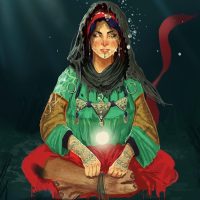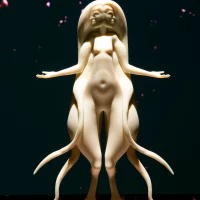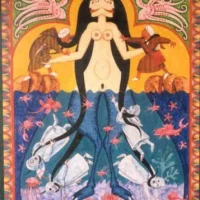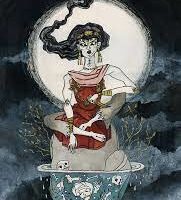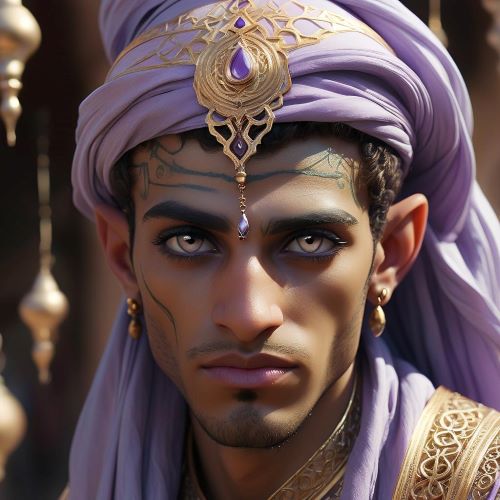Aisha Qandisha : The African Succubus
Listen
At a glance
| Description | |
|---|---|
| Origin | North African Mythology |
| Classification | Hybrids |
| Family Members | N/A |
| Region | Morocco |
| Associated With | Evil, Murder |
Aisha Qandisha
Introduction
Aisha Qandisha, alternatively referred to as Aicha Kandicha, emerges as a compelling entity within Moroccan folklore. She stands among a pantheon of folkloric beings akin to jinn but distinguished by unique traits and narratives. With origins deeply entrenched in the cultural tapestry of North Africa, particularly Morocco, Aisha Qandisha embodies a figure both enchanting and fearsome. Portrayed as a succubus or jinn, her legend reverberates through the ages, serving as both a cautionary narrative for men and a captivating subject for those drawn to the mysterious realms of folklore.
Physical Traits
Aisha Qandisha is commonly depicted as a striking young woman, distinguished by a unique physical attribute—a lower body reminiscent of a hoofed animal, such as a goat or camel. This distinct characteristic sets her apart from other mythological entities, contributing to her enigmatic allure. Legend has it that she employs her captivating beauty to enchant local men, only to later drive them to madness or even death. Aisha Qandisha’s appearance is a captivating fusion of allure and menace, with regional variations in depictions but recurring themes.
Often portrayed as an exquisite woman adorned with cascading locks and a gaze that bewitches onlookers, her beauty conceals a deceptive truth. Below the waist, her form undergoes a startling transformation, revealing the animalistic presence of hooves—whether goat, camel, or donkey—replacing human legs, symbolizing her intimate connection to the natural world. This juxtaposition of beauty and beastliness underscores the peril inherent in her allure, where seduction veils a potentially lethal essence.
Family
The origins of Aisha Qandisha are veiled in enigma, giving rise to various theories attempting to unravel her elusive past. Among these, some posit that she was introduced by Phoenician colonies in North Africa before being assimilated into Islamic traditions. However, such conjectures stem from dated interpretations of ancient Near Eastern deities, leaving much to speculation. Aisha Qandisha’s familial lineage remains an enigmatic aspect of her lore, with divergent tales attributing her lineage to the jinn, formidable supernatural entities endowed with autonomy. Alternately, she is sometimes associated with a particular class of jinn referred to as “Ayakhs,” renowned for their shape-shifting prowess and mischievous inclinations. Furthermore, whispers persist of her potentially being a human sorceress who, through the wielding of dark magic, transcended mortality, forever bound to an animalistic form, perpetuating the mystery surrounding her origins.
Other names
Aisha Qandisha is recognized under a plethora of names, among them Lalla Aïcha, Aïcha Soudaniyya, and Aïcha l’gnaouia. These appellations often serve as veiled references to avoid directly invoking her name. In the southern reaches of Morocco, she is referred to as “Kharaja.” Aisha Qandisha’s identity transcends a singular name, resonating across Morocco with a diverse array of titles, each illuminating a distinct aspect of her legend. While “Aicha Kandisha” remains the most prevalent, others such as “Lalla Aisha” convey reverence, while designations like the formidable “Spicy Aicha” or “Aicha of the Sea” evoke her more menacing aspects.
Powers and Abilities
Aisha Qandisha commands formidable powers beyond her captivating visage. Utilizing seduction as her primary weapon, she ensnares unsuspecting men with her charm, leading them towards perilous fates. Once entrapped, she can inflict madness, possess their very beings, or extinguish their lives altogether. Legends further embellish her abilities, attributing to her the gift of shapeshifting, enabling her to assume the forms of animals or even impersonate other women, heightening the deception upon her victims.
Believed to inhabit locales adjacent to water sources, Aisha Qandisha predominantly targets young men, luring them through her allure or by assuming the guise of their spouses. Local folklore often intertwines additional beliefs, such as her purported aversion to steel knives and needles, hinting at potential vulnerabilities amidst her mystique. Furthermore, tales speak of a male counterpart known as Hammu Qayyu, adding layers to her mythos.
Modern Day Influence
Aisha Qandisha’s narrative reverberates through modern Moroccan culture, embodying a potent symbol of resistance against European colonialism in Morocco. Her legend permeates discussions within literary and folklore studies, underscoring the enduring resonance of her tale. Contemporary explorations of Aisha Qandisha delve into themes of femininity, power, and the supernatural, mirroring evolving perspectives on gender and spirituality. Moreover, her imagery and symbolism find resonance across diverse domains, from advertising endeavors to political discourse, cementing her stature as a resilient and adaptable figure within North African mythology.
Her saga finds adaptation across various mediums, including films, novels, and even video games, underscoring an enduring fascination with her multifaceted character. Within Moroccan art and literature, her visage remains omnipresent, serving as a poignant reminder of the allure’s potency, the perils of unchecked desires, and the enduring interplay of the supernatural within daily existence. Notably, some interpretations cast Aisha Qandisha as a symbol of female empowerment, challenging patriarchal constructs and embodying women’s agency within a predominantly male-dominated society.
Related Images
Frequently Asked Questions
What is lorem Ipsum?
I am text block. Click edit button to change this text. Lorem ipsum dolor sit amet, consectetur adipiscing elit. Ut elit tellus, luctus nec ullamcorper mattis, pulvinar dapibus leo.
What is lorem Ipsum?
I am text block. Click edit button to change this text. Lorem ipsum dolor sit amet, consectetur adipiscing elit. Ut elit tellus, luctus nec ullamcorper mattis, pulvinar dapibus leo.
What is lorem Ipsum?
I am text block. Click edit button to change this text. Lorem ipsum dolor sit amet, consectetur adipiscing elit. Ut elit tellus, luctus nec ullamcorper mattis, pulvinar dapibus leo.
What is lorem Ipsum?
I am text block. Click edit button to change this text. Lorem ipsum dolor sit amet, consectetur adipiscing elit. Ut elit tellus, luctus nec ullamcorper mattis, pulvinar dapibus leo.
What is lorem Ipsum?
I am text block. Click edit button to change this text. Lorem ipsum dolor sit amet, consectetur adipiscing elit. Ut elit tellus, luctus nec ullamcorper mattis, pulvinar dapibus leo.

